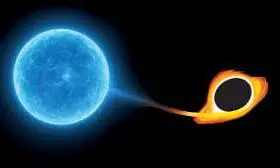
Astronomers uncover most powerful explosions since the big bang: a new class of cosmic eruptions
text_fieldsAstronomers have identified a new category of colossal cosmic outbursts, dubbed "extreme nuclear transients" (ENTs), which are now considered the most powerful explosions observed since the Big Bang.
These rare and extraordinary events occur when massive stars—three or more times the size of our Sun—are violently torn apart by supermassive black holes.
While tidal disruption events (TDEs), where stars are pulled into black holes, have been studied for years, these newly identified ENTs are far more luminous. Some have been found to be nearly ten times brighter than standard TDEs, reshaping our understanding of energy release in the most hostile regions of the universe.
The discovery, published in Science Advances, stems from observations by the European Space Agency’s Gaia spacecraft, which captured two unusually bright flares in 2016 and 2018. These enigmatic events puzzled scientists until a third similar flare was recorded in 2020 by the Zwicky Transient Facility (ZTF), confirming the emergence of a new explosive phenomenon.
Lead researcher Jason Hinkle of the University of Hawaii’s Institute for Astronomy identified the flares as ENTs due to their immense energy output and prolonged duration. Unlike supernovae, which are already extremely powerful, ENTs surpass them in both brightness and longevity.
“These flares are shining a light on the growth of supermassive black holes in the universe,” said co-author Benjamin Shappee, a Hubble Fellow at the Institute for Astronomy (IfA). The visibility of ENTs across vast cosmic distances offers a new lens for studying black holes and the energetic processes that fuel their evolution.
One such ENT, known as Gaia18cdj, exemplifies the scale of these events. With brightness exceeding 100 times that of a typical supernova, and durations far longer than previously observed black hole-star interactions, ENTs offer a unique opportunity for astronomers to examine the dynamic relationship between black holes and their environments.
In addition to helping scientists understand how black holes grow and consume matter, ENTs may become a powerful tool for cosmological studies, offering statistical insight into galactic evolution and energy transmission across the cosmos.

















